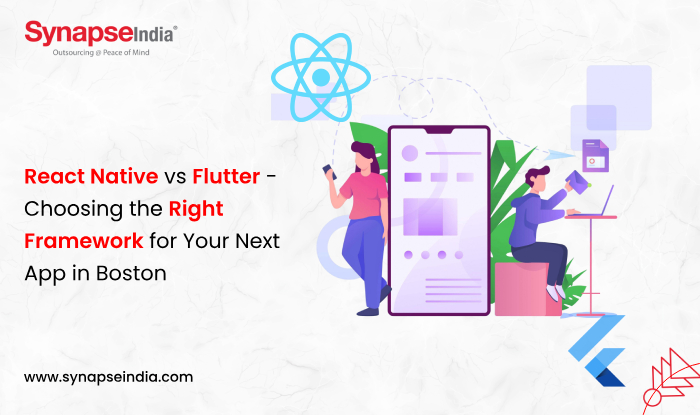 31 Jul 2025
31 Jul 2025
The mobile app market is expected to generate $935 billion in revenue (Market.us Scoop, 2025), making it a critical time for Boston businesses to invest in apps that captivate users.
Selecting the right framework, React Native or Flutter can make or break your project. Both are powerful cross-platform tools, but their differences in performance, development experience, and UI capabilities require careful consideration.
Here’s a detailed comparison to guide your decision, with insights tailored for the vibrant Boston tech scene.

React Native, launched by Facebook in 2015, uses JavaScript and React to build mobile apps for iOS and Android. It’s known for leveraging native components, offering a near-native experience. Companies like Facebook, Instagram, and Airbnb rely on React Native for its flexibility and large developer community.
Flutter, introduced by Google in 2017, uses the Dart programming language to create apps for mobile, web, and desktop from a single codebase. Its widget-based architecture ensures consistent, high-performance UIs. Apps like Google Ads and eBay Motors showcase Flutter’s ability to deliver visually rich experiences.
Research suggests Flutter has gained significant traction. 46% of developers worldwide used Flutter, compared to 35% for React Native (Statista). This trend likely continues into 2025, driven by Flutter’s multi-platform support and performance advantages
On GitHub, Flutter boasts over 172K stars compared to React Native’s 123K reflecting strong community engagement.
However, React Native benefits from JavaScript’s widespread use, making it easier to find developers, especially in tech hubs like Boston. Its mature ecosystem, with thousands of npm packages, supports rapid development. Flutter’s pub.dev, while growing (over 33,000 packages in 2023), is catching up but may not yet match React Native’s breadth.
In parallel with rising developer interest, consumer spending on mobile apps hit $36.2 billion in Q2 2024—up 12% year-over-year. Entertainment apps topped the charts with $9 billion, highlighting the need for smooth, high-performance user experiences (Statista).
Flutter often outperforms React Native due to its compilation to native ARM code, bypassing the JavaScript bridge used by React Native. Flutter maintains frame rates of 60-120 FPS and uses 43.42% CPU power, compared to React Native’s 52.92%. This makes Flutter ideal for apps with complex animations or high-performance needs, such as gaming or media apps popular in LA’s creative industries.
React Native, while slightly slower for complex UIs, performs well for most applications. Its reliance on native components ensures smooth integration with platform-specific features, which is valuable for apps requiring deep device access, like location-based services common in LA.
For teams in Boston with JavaScript expertise, React Native app development services offer a familiar environment, reducing onboarding time. The framework’s hot reload speeds up iteration, and its vast npm ecosystem provides ready-made solutions for common features like payments or notifications.
Flutter requires learning Dart, which may pose a learning curve. However, Dart’s strong typing and null safety enhance code reliability. Flutter’s hot reload and comprehensive widget library streamline UI development, making it appealing for startups aiming for rapid prototyping. Both frameworks support modern IDEs like Visual Studio and Android Studio, ensuring a robust development setup.
The UI/UX market is projected to grow from $2.2 billion in 2025 to $9.28 billion by 2030, at a CAGR of 33.35%(Mordor Intelligence).
Flutter’s widget-based system allows pixel-perfect, consistent designs across platforms, ideal for brands needing a unified look, such as LA-based media or e-commerce companies. Its Impeller rendering engine, introduced in 2025, enhances UI smoothness and predictability.
React Native uses native components, offering a more authentic platform-specific look but requiring extra effort for cross-platform consistency. Recent updates, like TypeScript integration and Flexbox Gap, improve its UI flexibility, making it suitable for apps needing native-like interactions, such as social media platforms.
React Native’s JavaScript foundation gives it an edge with integrations, leveraging npm’s extensive library for services like Firebase, Google Pay, or social media APIs. This is crucial for LA businesses integrating with local services like payment gateways or delivery platforms.
Flutter supports integrations through pub.dev and platform channels, with strong Google-backed tools like Firebase. While its ecosystem is smaller, it covers 98% of common use cases in 2025, and third-party solutions like Shorebird enable OTA updates, though React Native’s OTA capabilities are more mature.
Both frameworks reduce costs by using a single codebase for iOS and Android, cutting the need for separate development teams. React Native can be faster for simple apps, with development times as low as 2.5 hours for basic prototypes, compared to Flutter’s 4 hours. However, Flutter’s streamlined UI development and lower maintenance needs due to fewer third-party dependencies can save costs for complex projects.
Developer salaries also impact costs. In 2024, Glassdoor reported Flutter developers earn more than React Native developers, but Flutter’s faster hiring process (lower recruitment time) can offset this for LA businesses.
| Factor | Flutter Advantage | React Native Advantage |
|---|---|---|
| Development Time | Faster for complex UIs | Quicker for simple apps |
| Developer Cost | Higher salaries, faster hiring | Lower salaries, larger talent pool |
| Maintenance | Less dependency on third-party tools | More dependencies, mature ecosystem |
For Boston businesses, partnering with a trusted React Native app development company in the USA or India, like SynapseIndia, ensures success. With over 25 years of experience and 10,000+ projects delivered, SynapseIndia offers:
Whether you need a quick MVP or a complex app, SynapseIndia’s React Native app development services deliver results that align with your business goals.

Choosing between React Native and Flutter in 2025 depends on your project’s needs. Flutter offers superior performance and multi-platform support, ideal for visually rich apps. React Native excels in rapid development and native integration, perfect for JavaScript-savvy teams. For Boston businesses, SynapseIndia’s expertise in React Native app development services makes them a top choice to bring your app vision to life.
Ready to build your next app? Contact SynapseIndia, a leading React Native app development company in India and the USA, to create a high-quality, user-friendly app that drives success.
Reach out today at SynapseIndia!
React Native uses JavaScript and native components for a platform-specific look, while Flutter uses Dart and its own rendering engine for consistent, customizable UIs across platforms.
Flutter’s high performance and animation capabilities make it better suited for games, though both can integrate with game engines like Unity for more complex projects.
React Native offers near-native performance for most apps but may lag slightly in resource-intensive tasks compared to fully native development.
Yes, React Native Web allows React Native components to run on the web, offering a unified codebase for mobile and web apps.
Flutter is likely to gain more market share due to its performance and multi-platform support, while React Native will remain popular for its community and ecosystem.

 31 Jul 2025
31 Jul 2025
